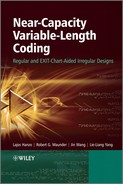Part I
Regular Concatenated Codes and Their Design
List of Symbols in Part I
General notation
- The superscript * is used to indicate complex conjugation. Therefore, a* represents the complex conjugate of the variable a.
- The superscript T is used to denote the matrix transpose operation. Therefore, aT represents the transpose of the matrix a.
- The superscript H is used to indicate the complex conjugate transpose operation. Therefore, aH represents the complex conjugate transpose of the matrix a.
- The notation
 represents the estimate of x.
represents the estimate of x.
Special symbols
| A | A random discrete source. |
| A source alphabet. | |
| A | The area under an EXIT curve. |
| The area under the inverse curve of an EXIT function. | |
| Ac | The a priori Logarithmic Likelihood Ratios (LLRs) of the encoded bits. |
| Au | The a priori LLRs of the information bits. |
| Ak | The forward recursion metric of a MAP decoder in the log domain. |
| ai | The legitimate symbols of a source alphabet. |
| Bk | The backward recursion metric of a MAP decoder in the log domain. |
| bmin | The overall minimum block distance of a VLC. |
| C | A VLC. |
| C | The encoded output sequence of a trellis encoder. |
| Ck | The encoded output symbol of a trellis encoder. |
| CUI | The channel capacity when using uniformly distributed input. |
| cmin | The minimum convergence distance of the VLC. |
| cj | A VLC codeword. |
| c(e) | The output symbol associated with an edge e in a trellis. |
| dbk | The minimum block distance for the length Lk of a VLC. |
| dc | The convergence distance between two different-length codewords. |
| dd | The divergence distance between two different-length codewords. |
| df | The free distance of a VLC. |
| dmin | The minimum divergence distance of a VLC. |
| dh | The Hamming distance between two identical-length VLC codewords. |
| Eu | The a posteriori LLRs of the information bits. |
| Ec | The a posteriori LLRs of the encoded bits. |
| Eb | Bit energy. |
| Eb/N0 | Ratio of the bit energy to the noise power spectral density. |
| Es | Symbol energy. |
| Es/N0 | Ratio of the symbol energy to the noise power spectral density. |
| e | The edge of a trellis. |
| FN | The extended code of order N of a VLC. |
| gk | The generator polynomials of a convolutional code. |
| H | The entropy of a source. |
| hk | The coefficients of a channel impulse response. |
| Ii | The information carried by a source symbol. |
| The average codeword length of a VLC. | |
| l(cj) | The length of a VLC codeword cj in terms of code symbols, or bits for binary codes. |
| N0 | Single-sided power spectral density of white noise. |
| n | The length distribution vector of a VLC. |
| Pi | The state probabilities of a discrete Markov model. |
| pi | The source symbol probabilities. |
| pij | The state transition probabilities of a discrete Markov model. |
| R | Coding rate. |
| RI | The source information rate measured in bits/second. |
| Rs | The source emission rate measured in symbols/second. |
| S | The set of valid states of a trellis encoder. |
| sS(e) | The starting state of an edge e in a trellis. |
| sE(e) | The ending state of an edge e in a trellis. |
| U | The input symbol sequence of a trellis encoder. |
| Uk | The input symbol of a trellis encoder. |
| u(e) | The input symbol associated with an edge e in a trellis. |
| Xi | The states of a discrete Markov model. |
| α | The forward recursion metric of a MAP decoder. |
| β | The backward recursion metric of a MAP decoder. |
| γ | The branch transition metric of a MAP decoder. |
| ρ | The correlation coefficient of a first-order Markov model. |
| η | The efficiency of a VLC. |
| ν | The code memory. |
| Γk | The branch transition metric of a MAP decoder in the log domain. |
| Π | Interleaver. |
| Π-1 | Deinterleaver. |
